
|
You entered: background
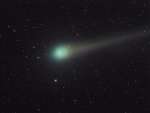 Comet Lulin and Distant Galaxies
Comet Lulin and Distant Galaxies
7.03.2009
Now fading in our night sky, Comet Lulin has provided some lovely cosmic vistas. Moving rapidly against the background of stars, Lulin briefly posed with the likes of Saturn, and Regulus (Alpha Leo). But here it is seen against a field of distant galaxies.
 Looking Through Abell 68
Looking Through Abell 68
8.03.2013
Want to use a cluster of galaxies as a telescope? It's easier than you might think as distant galaxy clusters naturally act as strong gravitional lenses. In accordance with Einstein's theory...
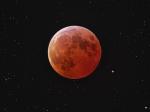 Eclipsed Moon and Stars
Eclipsed Moon and Stars
8.03.2007
This dramatic image features a dark red Moon during a total lunar eclipse -- celestial shadow play enjoyed by many denizens of planet Earth last Saturday. Recorded near Wildon, Austria, the picture is a composite...
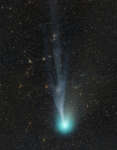 Structure in the Tail of Comet 12P/Pons Brooks
Structure in the Tail of Comet 12P/Pons Brooks
16.02.2024
Heading for its next perihelion passage on April 21, Comet 12P/Pons-Brooks is growing brighter. The greenish coma of this periodic Halley-type comet has become relatively easy to observe in small telescopes. But the bluish...
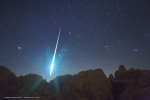 Mojave Desert Fireball
Mojave Desert Fireball
17.12.2009
Monstrously bright, this fireball meteor lit up the Mojave Desert sky Monday morning, part of this year's impressive Geminid meteor shower. Seen toward the southwest over rock formations near Victorville, California, a more familiar celestial background was momentarily washed out by the meteor's flash.
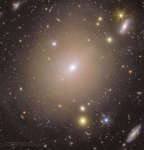 APOD: 2025 February 26 Б Einstein Ring Surrounds Nearby Galaxy Center
APOD: 2025 February 26 Б Einstein Ring Surrounds Nearby Galaxy Center
26.02.2025
Do you see the ring? If you look very closely at the center of the featured galaxy NGC 6505, a ring becomes evident. It is the gravity of NGC 6505, the nearby (z = 0.042)...
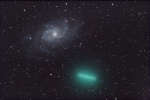 APOD: 2008 January 2- A Galaxy is not a Comet
APOD: 2008 January 2- A Galaxy is not a Comet
2.01.2008
This gorgeous galaxy and comet portrait was recorded on December 30th, in the skies over Hoogeveen, The Netherlands. The combined series of 60 x 60 second exposures finds the lovely green coma of Comet 8P/Tuttle near its predicted conjunction with the Triangulum Galaxy.
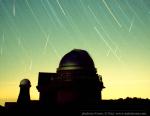 Leonids Over Korean Observatory
Leonids Over Korean Observatory
12.12.2001
There were two peaks to this year's Leonid Meteor Shower. The first peak was best seen during the early morning hours of November 18 in North America, while the second peak, almost twice the intensity of the first, occurred eight hours later and was best seen from Asia.
 A Network of Microlensing Caustics
A Network of Microlensing Caustics
15.12.2002
A virtual sky map like this would be of interest to astronomers studying gravitational microlensing. In microlensing, the gravity of stars near the line of sight can act to magnify the light of background objects such as distant stars, or quasars. Nowhere is this magnification greater than near a gravitational lensing caustic.
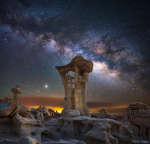 APOD: 2020 August 13 Б Jupiter and Saturn Rising Beyond Alien Throne Rock
APOD: 2020 August 13 Б Jupiter and Saturn Rising Beyond Alien Throne Rock
13.08.2020
Whatбplanets are those behind that unusualбrock spire? Saturn (lower left) and Jupiter.б This month, after sunset, the bright planetary duo are quite prominent toward the southeast.б Now your view of our Solar...
|
January February March April |
|||||||||||||||||||||||||||||||||||||||||||||||||